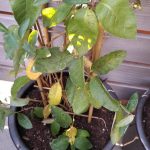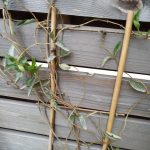I have two planters in a sunny spot on my porch with this plant in it , a few weeks ago the bottom leaves started to get kind of spotty and yellow and fall off, it had been growing really well with flowers that came back too. Sheridan Nurseries thinks I over watered, I did water every second day, but it was very hot this summer. Now the middle part has leaves with a white film on them falling off too, although I see new shoots about to come out of the bottom part where the first leaves came off. I would like this plan to be alive next year both plants did really well growing up the fence. They had me give it some fertilizer 15-30-15. I want to cover this plant I think with burlap over the winter on the bottom so that it can regrow next summer. I don’t know if this really came from over watering and now I am careful how much water I give to them, the pots have drainage.


It appears that your honeysuckle vines are suffering from honeysuckle powdery mildew infection, caused by the fungus Erysiphe caprifoliacearum var. flexuosa. Powdery mildew infections are more likely when humidity is high, night time temperatures are warm, and air circulation is limited.
Powdery mildew infection is usually not fatal. Dehydrated plants are more susceptible to powdery mildew infection, so keep your plants well-watered and perhaps consider mulching to help conserve soil moisture. You may want to remove the leaves that are severely infected. Fungal spores overwinter in dead leaves so be thorough in cleaning up all dead leaves around the plant and put them in the garbage, not the compost bin or yardwaste bag. If you use any tools with the plant (e.g. pruners, gloves), remember to sterilize them after each use, to prevent re-infection. Fertilization at this late a time is probably not helpful, since the new growth is unlikely to harden-off in time to survive the winter.
Chemical control of powdery mildew is not always necessary, and are really effective only when used at the first signs of infection or as a preventive. If you feel that your situation warrants it, you can try using a fungicidal soap to contain the infection. Sulphur-based sprays can be a good means to prevent future infections when used very early in the season, before the infection appears. As with all chemicals, read and follow the instructions carefully.
Here is a short article from the Royal Horticultural Society on powdery mildew if you are interested. If you want more information, this article from the University of California is good. Both mention fungicides. Please note that in Ontario, the use of certain types of fungicides are not permitted for ornamental purposes, so please double-check before use.
As for overwintering the honeysuckle vines in the planters, the key is to insulate the plant as much as possible from temperature fluctuations, and protect from the cold, dry winds. Try to provide as much insulation as possible (e.g. larger planter, insulated planter), and as much protection from cold drying winds as possible (e.g. move to a more sheltered location, erect barriers around the planter). Burlap wrapping is effective in providing aboveground protection of foliage (but make sure it doesn’t actually touch the foliage, or it could actually make it worse), but is of little use in root protection. For more ideas on overwintering a plant in a pot, here is a pertinent article from the Brooklyn Botanic Garden.
Best of luck with your honeysuckle vines!

